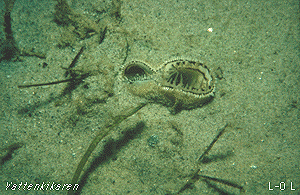|
Siphons with eyes
The two siphons have grown together and
with larger individuals are of such a size that they no longer can be
accomadated in the shell. The siphons can attain a length that is twice
that of the shell and reach up slightly over the bottom sediment. Their
diet is composed of plankton that is sucked in with water via the inhalent
siphon.
If you should wade out onto a shallow sandy bottom, it is
possible to see the siphons as two holes in the sand surrounded by light
sensitive tentacles, and if a shadow falls on them, the gaper pulls them
together and the hole disappears quickly.

The siphons on a sand gaper. The inhalent siphon is
situated on the right and the exhalent on the left. Some loose eel grass
is also seen in the picture.
Immigrants
The Sand gaper, originally a North American
species, is now very common on sandy bottoms along the west coasts of
Europe. It is a rather late immigrant to the Baltic
Sea, but has during the 20th centuary moved northwards. It arrived
on the Swedish west and south coasts at the beginning of the centuary,
and has since then spread so far, that it is becoming more and more common
in the Stockholm archipelago. On the Finnish side of the Gulf of Bothnia,
it has been found as far north as mid-Finland.
Food in the USA
In the USA and Canada several thousand
tons of Sand gapers are fished annually, while in Europe the Sand gaper
is not as popular. Sand gapers are fished by using a large scraper that
is pulled along the bottom.
|

|
Page
2 of 2
|
|
|